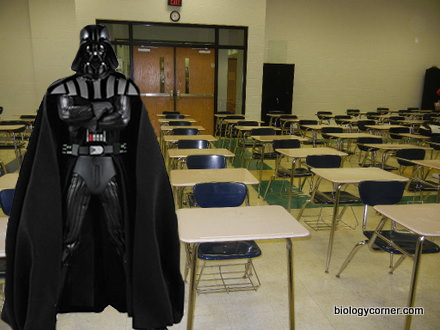In 1998, I was still a new teacher but I’d had a couple of years behind me and was just getting the hang of organizing lesson plans, keeping the class focused and not burying myself under a pile of homework. When I arrived to school that August I found something unusual on my schedule, something unexpected: an hour study hall. I had plans for that first day of school even!
I didn’t think much about it until my department head strolled into my room with a somewhat apologetic look on his face, and proceeded to explain how I was the only one with the right timing to take the study hall.
I couldn’t figure out why he was so worried, I’d had study halls before, every teacher gets a half hour lunch study to supervise. In fact, I was rather looking forward to having a whole hour, imagine the things I could get done, papers graded, plans made. I could even get to revising all those old worksheets.
The First Day
The day arrived when the students showed up and I headed down to the study hall room, this room had 110 empty desks when I walked in. I dropped my stuff off at the front desk and watched as about 140 students showed up to study hall. All the chairs were full and the students were lining up around the outside of the wall, it was right about here that panic started to set in. Schedules were eventually fixed and I ended up having only about 90 students in that study hall but from the start to the end of the semester it was a disaster. The students were unruly, they talked, they threw stuff, some would randomly switch seats when I wasn’t looking. I was frazzled every day at the end of that hour and really never wanted another one of those duties ever again.
Years later, I have hour study halls now and then but they aren’t that bad now. The things that went wrong that first year I have corrected and now I actually do get projects done in study hall, but you must approach the whole thing in a way you probably wouldn’t do in a regular education class. We aren’t trained to deal with 90 kids all crammed in one room with nothing to do. No one is trained for that, except maybe prison guards. What I’ve learned, I’ve learned by trial and error. I have younger teachers, looking as frazzled as I was that first year , ask me how I do it. So, here goes…some basic guidelines for surviving the hour study.
1. Do not expect to get anything done that first couple of weeks. Don’t bring your newspaper or your stacks of paper or your laptop. Bring a clip board with the seating chart on it and a pen. That’s it. You’d be amazed at the power of the clipboard.
2. Don’t sit the first couple of weeks. Patrol the classroom, walk up and down the aisles watching for anyone that is not sitting forward or working on something. If their eyes are furtively glancing around or looking at you – that means they’re up to something. Patrol that area until the suspicious behavior goes away (and it will).
3. What might be minor infractions in a regular ed classroom are major ones in these big rooms. Don’t let them move seats, don’t let them talk (ever!), and in general keep them facing the front of the room. I don’t mind if they lay their heads down, but that’s personal preference, some teachers make them sit up.
4. Less talking to students is better. You are not going to make meaningful connections here. You want your students to look at you like you were Darth Vader. You want them to NOT want to attract your attention. Practice the cold stare. It’s better also to go to the student who is up to something and lean down and whisper to him rather than yell across the big room. Other students don’t know what you said, but in their mind it could have been horrific jedi mind tricks. Often I simply tap them on the shoulder, and say “eyes forward.” It’s ominous. It works.

5. In the end, you are basically teaching your charges that they don’t want your attention. Even bathroom passes and other requests should be painful. Don’t let them get up and come to you. If you see them start to get up for any reason, point at them, quietly mouth “sit” and then go to their location. This also stops the kids that make an elaborate production about throwing trash away or sharpening their pencils.
6. After about two weeks of being Darth Vader, the students will settle in a routine where they come in, sit down, eyes forward and are quiet. Most will have realized they can’t goof off and talk to their friends and will bring something to occupy themselves. At this point, you can relax your guard and start doing your own projects.
7. Even after you have them trained, be wary of the beginning and end of the hour. This is usually where students will test their limits. It may be a good idea to continue the patrols during these times.
*Adding a disclaimer here at the end, lest my readers think this is how I treat all of my students. My biology classes are much more relaxed, but they are small groups of 20-30.

